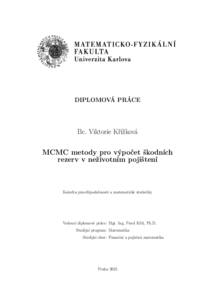MCMC metody pro výpočet škodních rezerv v neživotním pojištení
MCMC methods for claims reserving in non-life insurance
diploma thesis (DEFENDED)

View/
Permanent link
http://hdl.handle.net/20.500.11956/197065Identifiers
Study Information System: 249953
Collections
- Kvalifikační práce [11342]
Author
Advisor
Referee
Mazurová, Lucie
Faculty / Institute
Faculty of Mathematics and Physics
Discipline
Financial and insurance mathematics
Department
Department of Probability and Mathematical Statistics
Date of defense
4. 2. 2025
Publisher
Univerzita Karlova, Matematicko-fyzikální fakultaLanguage
Czech
Grade
Good
Keywords (Czech)
Markov chain Monte Carlo|neživotní pojištění|škodní rezervyKeywords (English)
Markov chain Monte Carlo|non-life insurance|claims reservesPráce se zabývá metodou Markov chain Monte Carlo a jejím použití při výpočtu škodních rezerv. Obecně zavádí značení a nástroje používané v rámci neživotního po- jištění, následně zmiňuje běžně používané modely, nevyužívající bayesovskou statistiku. Poté představuje model bayesovské statistiky, ve kterém je možné analyticky vyjádřit aposteriorní rozdělení škod a popisuje metodu Markov chain Monte Carlo, která je pou- žívána v situacích, kdy analytické vyjádření aposteriorního rozdělení není možné. MCMC metoda je implementována v softwaru R na vybraná data, je ověřena její konvergence a zkoumána citlivost na vstupní parametry. V závěru je porovnána s dalšími zmíněnými metodami. 1
The diploma thesis deals with the Markov chain Monte Carlo method and its use in the calculation of claims reserves. It introduces the tools and terms used in non-life insurance, then mentions a commonly used models that do not use Bayesian statistics. Subsequently, it presents a Bayesian statistics model in which it is possible to analytically express the posterior distribution of claims and then describes the Markov chain Monte Carlo model, which is used in situations where analytical expression of the posterior distribution is not possible. The MCMC method is implemented in R software on selected data, its convergence is verified and the sensitivity to input parameters is examined. In the end, it is compared with the other mentioned methods. 1
